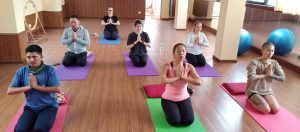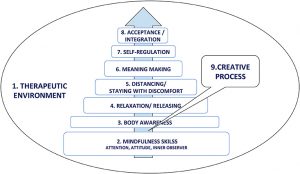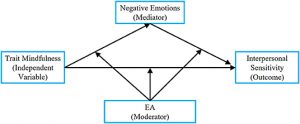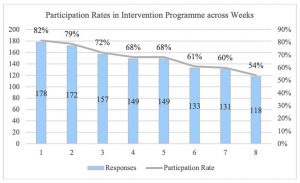Mindfulness, Enlightenment, and Quantum Entanglement
“If quantum mechanics hasn’t profoundly shocked you, you haven’t understood it yet. Everything we call real is made of things that cannot be regarded as real.” – Niels Bohr
The idea of Quantum Entanglement has shaken the world of physics contradicting classical physics including relativity. It is a very complex notion that is difficult to express outside of complex mathematical expressions. But in its essence, it suggests that matter is entangled with other matter with the states of particular particles linked to the states of other particles even over large distances. So, when a photon (quantum of light) changes its state, an entangled photon simultaneously changes its state even far away.
“Quantum entanglement is a label for the observed physical phenomenon that occurs when a pair or group of particles is generated, interact, or share spatial proximity in a way such that the quantum state of each particle of the pair or group cannot be described independently of the state of the others, even when the particles are separated by a large distance.” – Wikipedia,
This is not just a theoretical notion. As strange as it may seem there has accumulated evidence that Quantum Entanglement occurs ubiquitously in nature. Its implications are profound and revolutionize our views of the nature of the universe including notions of space and time themselves. Without belaboring the immensely complex physics and mathematics underlying the notion, the idea of Quantum Entanglement fits amazingly well with eastern spiritual thoughts, including the notions of mindfulness and enlightenment.
Everything is interconnected. This is a notion fundamental to eastern spiritual teachings. The Buddha referred to this as interdependent co-arising. The teaching was that everything arises in dependence upon multiple causes and conditions; nothing exists as a singular, independent entity. Indeed, it is evident to anyone who wishes to look closely at anything that it is connected to everything else. In other words, everything that happens is entangled with everything else and nothing can be viewed solely alone without reference to other things.
The paper that this may be printed on is in one way or another connected to everything else in the universe. The paper was manufactured from tree pulp. For the tree to have grown and produce this pulp there was sunlight, soil, water, and seeds provided by prior trees. The harvesting of the trees required lumbering and transportation of the trees to a mill. The manufacturing requires machinery that was invented by people who were trained based upon the accumulated knowledge of generations. After manufacture it was transported by truck requiring trained drivers, fuels, roads etc. all of which required a myriad of other components and actions. The actual atoms of which it is composed were created billions of years ago in the explosions of stars called supernovas. These, in turn stretch back to the Big Bang itself, where all matter and energy emerged at once. Perhaps by now you get the idea that the piece of paper is connected to everything else on the universe.
The notion of Quantum Entanglement indicates that all particles created at the same time are entangled and the state of any one of them is affected by all the others no matter where they are. Since, all particles emerged with the Big Bang, then all of them are entangled. This notion then is the science of physics way of expressing that everything is interconnected even on the quantum level of subatomic particles. This includes us. We are all entangled both on the fundamental quantum level and also on the perceived physical level. Each of us is connected to everyone else and to everything else in the universe. It’s all one.
The notion of Quantum Entanglement indicates that the linkage of particles can occur simultaneously over very large distances, distance large enough that any effect of one particle on the other would have to move at faster than the speed of light. This suggests that their entanglement is in the now. Time is irrelevant. Just as consciousness exists only in the now where there is no time. This suggests the interesting possibility that consciousness itself is an entangled phenomenon.
Consciousness has been termed as an observerless observer; a phenomenon where causes have no further effects. Something registers what is going on but is not itself changed by it and doesn’t affect anything else. It’s an end point on a chain of causation. This is much like the effect of a change in a particle producing instantaneous changes in another without further consequence. Perhaps, then, consciousness itself results from Quantum Entanglement.
Consciousness itself may be also entangled at the quantum level. It’s long been an understanding in quantum mechanics that the act of observing something fundamentally changes it. As a result, it is impossible to determine more than one aspect of a particle at a time. The act of observing one aspect changes the others. This gets even deeper on the quantum level where the classic double slit experiment demonstrated that observations actually change the behavior of particles. Indeed, “observations not only disturb what has to be measured, they produce it… We compel [a quantum particle] to assume a definite position. In other words, we ourselves produce the results of measurements.” – Pascual Jordan
These strange phenomena at the quantum level appear to defy our understanding of the universe just as the existence of awareness and consciousness appear to defy understanding. This suggests that they may occur for similar reasons. The fabric of the universe may well be entangled with consciousness.
“Nobody understands what consciousness is or how it works. Nobody understands quantum mechanics either. Could that be more than coincidence?” – Philip Ball
This and other Contemplative Studies posts are also available on Google+ https://plus.google.com/106784388191201299496/posts and on Twitter @MindfulResearch






